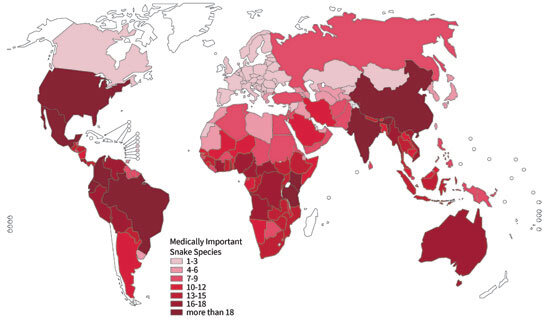Social Justice
Snakebite Envenoming
- 25 May 2019
- 4 min read
WHO has presented a strategy aimed at cutting snakebite-related deaths and disabilities in half by 2030, as snake bite can soon become a major Global Public Health Emergency if not dealt properly.
Facts
- Each year, nearly three million people are bitten by poisonous snakes, with an estimated 81,000-138,000 deaths.
- Another 400,000 survivors suffer permanent disabilities and other after-effects, according to the WHO figures.
- Snake venom can cause paralysis that stops breathing, bleeding disorders that can lead to fatal haemorrhage, irreversible kidney failure and tissue damage that can cause permanent disability and limb loss.
- From very long time snake bite has been neglected and dangerously under-estimated to the extent that in 2017 WHO, categorised "snakebite envenoming" as a Neglected Tropical disease.
Snakebite Envenoming
Snakebite envenoming is a potentially life-threatening disease that typically results from the injection of a mixture of different toxins (venom) following the bite of a venomous snake and can also be caused by having venom sprayed into the eyes by certain species of snakes that have the ability to spit venom as a defence measure.
- Snakebite envenoming is a particularly important public health problem in rural areas of tropical and sub-tropical countries situated in Africa, the Middle-East, Asia, Oceania and Latin America.
- In these regions the risk of snakebite is a daily concern, especially for rural and peri-urban communities where hundreds of millions of people depend on agriculture or subsistence hunting and gathering in order to survive.
- Children often suffer more severe effects than adults because of their smaller body mass.
- Lack of footwear contributes significantly to the risk of snakebite for both adults and children.
Concerns
- Many snakebites go unreported, often because victims seek treatment from non-medical sources or do not have access to health care.
- Snake antivenoms are effective treatments to prevent or reverse most of the harmful effects of snakebite envenoming and are included in the WHO Essential Medicines list but because of inaccessibility and unaffordability of drugs, many families are either not able to access the anti venoms or go into debt in order to pay for antivenom.
WHO’s Roadmap for Snake Envenoming
- To make antivenoms accessible and affordable WHO’s plan is to increase production of quality antivenoms.
- In order to create the sustainable market for antivenoms their is a need for a 25% increase in the number of competent manufacturers by 2030.
- WHO planned a pilot project to create a global antivenom stockpile.
- Integrating snakebite treatment and response into national health plans in affected countries, including better training of health personnel and educating communities.




